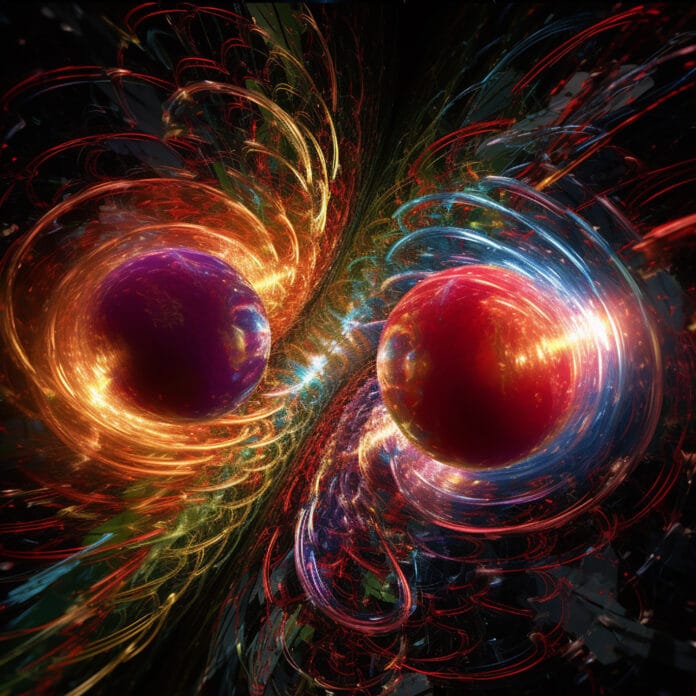Elastic scattering measurements at hadron colliders give unique experimental access to non-perturbative dynamics, which cannot be calculated from first principles. In a remarkable run of the LHC, proton–proton elastic-scattering events were recorded with an integrated luminosity using the ALFA subdetector of ATLAS.
As a part of the ATLAS Collaboration, physicists from the Institute of Nuclear Physics Polish Academy of Sciences measured the elastic scattering in proton-proton collisions at the LHC accelerator at a center-of-mass energy of 13 TeV. The measurements needed a specialized system due to the small scattering angles in such interactions (less than a thousandth of a degree).
Its main component was a set of detectors positioned more than 200 meters from the collision site that could measure dispersed protons at just a few millimeters from the accelerator beam.
This was possible thanks to the technique called Roman pots. The technique allows detectors to place inside the accelerator beam pipe and closely approach the beam during data taking. An essential contribution of the scientists was the work on the trigger and data acquisition system, which is necessary for data to be recorded.
The particular arrangement of magnetic fields that shaped the LHC accelerator beam was the second essential component of the experimental setup. Maximizing beam focussing is the objective in most measurements to boost the frequency of exciting interactions. However, the huge angular divergence of closely focused beams makes it extremely difficult to measure elastic scattering. This divergence is reduced by the unique magnet design, which also guarantees accurate measurements.
The distribution of the scattering angle, or more precisely, the distribution of the variable t, which is proportional to the square of that angle, is the direct outcome of the measurement, which was reported in European Physical Journal C. The distribution’s shape allowed for inferences about the underlying characteristics of strong nuclear interactions between protons at very high energies. The method of obtaining this information relies on elastic scattering’s quantum qualities, which are not present in a game of pool.
The so-called optical theorem, which results from probability conservation in quantum processes, is the first of these characteristics. It compares elastic interactions against inelastic ones or interactions that result in the production of new particles. Due to the high energy of the protons involved in the collisions under study, inelastic events typically occur. The entire cross-section value could be calculated using data of solely elastic interactions thanks to the optical theorem.
In particle physics, the cross-section is a quantity used to indicate how likely a given reaction is to occur. The probability of proton-proton collision is described by the total cross-section, which is correlated with proton size. The ATLAS Collaboration’s result is the most accurate measurement of this parameter at 13 TeV energy. The accurate detector position determination, which was under the IFJ PAN group’s purview, enabled great precision. The study validates a crucial characteristic of strong interactions: the rise in total cross-section with rising collision energy. This increase can be explained by the proton’s size growing as energy increases.
A precise understanding of the total cross-section is crucial for research into strong interactions and other fields of particle physics. Strong interactions play a vital role in various fields, including the search for novel physics, cosmic ray research, and experiments at the Large Hadron Collider (LHC), where they operate as background and cause cosmic air showers. Accurate measurements of elements like the overall cross-section make exact modeling of these processes possible.
Elastic scattering in proton-proton collisions can happen via two different mechanisms: strong nuclear interaction and Coulomb contact or the attraction of opposite electric charges. The interference between both mechanisms is the second effect of the analyzed process’s quantum character. Their scattering amplitudes determine the interference.
In quantum physics, the scattering amplitude is a gauge of probability. Its values are complex numbers rather than real numbers, unlike ordinary probability. As a result, either its magnitude and phase or its real and imaginary components are used to characterize it. We can learn more about the actual and hypothetical components of the nuclear amplitude by measuring the interference since Coulomb interactions are well understood, and their scattering amplitude can be estimated.
As measured experimentally, the ratio of the real to the imaginary sections of the nuclear amplitude is much smaller than predicted by pre-LHC theoretical models. These models are the result of particular strong interaction characteristics assumptions. These presumptions are put to the test by the observed discrepancy.
The initial presumption is that proton-antiproton collision properties are identical to proton-proton and antiproton-antiproton collisions at very high energy. This is because high-energy collisions only frequently happen between gluons, although quarks and gluons make up protons. The intuitive assumption is that the interactions in various systems are the same since protons and antiprotons have the same gluon structure. The theoretical models represent the experimental data by allowing for a difference, which is feasible due to the quantum nature of interactions.
The growing of the total cross section with energy is the second underlying presumption of the theoretical models. It was believed to exhibit the same characteristics at energies higher than those measured at the LHC accelerator. Another explanation for the observed disparity is slowing this development at energies exceeding the LHC energy.
The fundamental characteristics of the strong interaction at high energy are the subject of both proposed hypotheses. Whichever is true, the reported measurements improved our knowledge of the basic interactions between particles.
The detectors used in the described studies are being prepared for further measurements of elastic scattering at even higher energies. The Institute of Nuclear Physics Polish Academy of Sciences is also researching other processes in which both strong and electromagnetic interactions play significant roles. The technique of Roman pots plays a crucial role in these studies.
Journal Reference:
- Aad, G., Abbott, B., Abbott, D.C. et al. Measurement of the total cross-section and-parameter from elastic scattering in pp collisions at s√=13 TeV with the ATLAS detector. Eur. Phys. J. C 83, 441 (2023). DOI: 10.1140/epjc/s10052-023-11436-8
